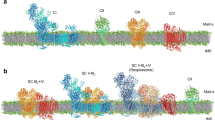Summary
SDS-polyacrylamide gel electrophoresis and immunoblotting were used to investigate inter- and intramolecular disulfide bonds to connexin 43 (the cardiac gap junctional protein) in isolated rat heart gap junctions and in whole heart fractions. In gap junctions isolated in the absence of alkylating agent, connexin 43 molecules are cross-linked by disulfide bonds. The use of iodoacetamide (100mm) for the first steps of isolation procedure prevents the formation of these artifactual linkages. Investigation of connexin 43 in whole heart fractions by means of antibodies confirms the results obtained with isolated gap junctions; that is, connexin 43 molecules are not interconnected with disulfide bridges. In whole heart fractions treated with alkylating agents, a 38 kD protein, immunologically related to connexin 43, and containing intramolecular disulfide bonds is detected. It is hypothesized that this protein might be a folded form of connexin 43, a precursory form of the molecules embedded in the gap junctions.
Similar content being viewed by others
Abbreviations
- BSA:
-
bovine serum albumin
- EDTA:
-
ethylene diamine tetra-acetic acid
- IAA:
-
iodoacetamide
- NEM:
-
N-ethylmaleimide
- PAGE:
-
polyacrylamide gel electrophoresis
- PMSF:
-
phenylmethylsfonyl fluoride
- SDS:
-
sodium dodecyl sulfate
- Tris:
-
trishydroxymethyl-aminomethane
References
Baker, T.S., Caspar, D.L.D., Hollingshead, C.J., Goodenough, D.A. 1983. Gap junction structure: IV. Asymmetric features revealed by low-irradiation microscopy.J. Cell Biol. 96:204–216
Beyer, E.C., Paul, D.L., Goodenough, D.A. 1987. Connexin 43: A protein from rat heart homologous to a gap junction protein from liver.J. Cell Biol. 105:2621–2629
Dupont, E., Aoumari, A. El, Roustiau-Sévère, S., Briand, J.P., Gros, D. 1988. Immunological characterization of rat cardiac gap junctions: Presence of common antigenic determinants in heart of other vertebrate species and in various organs.J. Membrane Biol. 104:119–128
Freedman, R.B. 1984. Native disulphide band formation in protein biosynthesis: Evidence for the role of protein disulphide isomerase.Trends Biochem. Sci. 9:438–441
Gros, D., Nicholson, B.J., Revel, J.P. 1983. Comparative analysis of the gap junction protein from rat and liver: Is there a tissue-specificity of gap junction?Cell 35:539–549
Guarnieri, C., Flamigni, F., Rossoni-Caldarera, C. 1979. Glutathione peroxidase activity and release of glutathione from oxygen deficient perfused rat heart.Biochem. Biophys. Res. Commun. 89:678–684
Henderson, D., Eibl, H., Weber, K. 1979. Structure and biochemistry of mouse hepatic gap junctions.J. Mol. Biol. 132:193–218
Hirokawa, N., Heuser, J. 1982. The inside and outside of gap junction membranes visualized by deep-etching.Cell 30:395–406
Johnson, D.A., Gantsch, J.W., Sportsman, J.R., Elder, J.M. 1984. Improved technique utilizing non-fat dry milk for analysis of proteins and nucleic acids transferred to nitrocellulose.Gene Anal. Techn. 1:3–8
Kistler, J., Christie, D., Bullivant, S. 1988. Homologies between gap junction proteins in lens, heart and liver.Nature (London) 331:721–723
Kosower, N.S., Kosower, E.M. 1978. The glutathione status of the cell.Int. Rev. Cytol. 54:109–160
Kumar, N.H., Gilula, N.B. 1986. Cloning and characterization of human and rat liver cDNAs coding for a gap junction protein.J. Cell Biol. 103:767–776
Laemmli, U.K. 1970. Cleavage of structural proteins during the assembly of the head of bacteriophage T 4.Nature (London) 227:680–685
Loewenstein, W.R. 1981. Junctional intercellular communication: The cell-to-cell membrane channel.Physiol. Rev. 61:829–913
Lowry, O.H., Rosebrough, N.J., Farr, A.L., Randall, R.J. 1951. Protein measurement with the Folin phenol reagent.J. Biol. Chem. 193:265–275
Manjunath, C.K., Goings, G.E., Page, E. 1984a. Cytoplasmic surface and intramembrane components of rat heart gap junctional proteins.Am. J. Physiol. 246:H865-H875
Manjunath, C.K., Goings, G.E., Page, E. 1984b. Detergent sensitivity and splitting of isolated liver gap junctions.J. Membrane Biol. 78:147–155
Manjunath, C.K., Nicholson, B.J., Teplov, D.B., Hood, L.E., Page, E., Revel, J.P. 1987. The cardiac gap junction protein (M r 47,000) has a tissue-specific cytoplasmic domain ofM r 17,000 at its carboxy-terminus.Biochem. Biophys. Res. Commun. 142:228–234
Manjunath, C.K., Page, E. 1986. Rat heart gap junctions as disulfide-bonded connexon multimers: Their depolymerization and solubilization in deoxycholate.J. Membrane Biol. 90:43–57
Merrified, R. 1963. Solid-phase peptide synthesis. 1. The synthesis of a tetrapeptide.J. Am. Chem. Soc. 85:2149–2154
Nicholson, B.J., Dermietzel, R., Teplov, D.B., Traub, O., Willecke, K., Revel, J.P. 1987. Two homologous protein components of hepatic gap junctions.Nature (London) 329:732–734
Nicholson, B.J., Gros, D., Kent, S.B., Hood, L.E., Revel, J.P. 1985. theM r, 28,000 gap junction protein from rat heart and liver are different but related.J. Biol. Chem. 260:6514–6517
Paul, D. 1985. Antibody against liver gap junction 27 kD protein is tissue-specific and cross-reacts with a 54 kD protein.In: Gap Junction. M.V.L. Bennett and D.C. Spray, editors. pp. 107–122. Cold Spring Harbor Laboratory, Cold Spring Harbor
Paul, D. 1986. Molecular cloning of cDNA for rat liver gap junction protein.J. Cell Biol. 103:123–134
Paul, D., Goodenough, D.A. 1987. A novel gap junction protein present in rat lens fibers.J. Cell Biol. 105:227a
Pitts, J.D., Finbow, M.E. 1986. The gap junction.J. Cell Sci. Suppl. 4:239–266
Revel, J.P., Yancey, B.S., Nicholson, B.J. 1986. The gap junction proteins.Trends Biochem. Sci. 11:375–377
Shibata, Y., Manjunath, C.K., Page, E. 1985. Differences between cytoplasmic surfaces of deep-etched heart and liver gap junctions.Am. J. Physiol. 249:H690-H693
Towbin, M., Staehelin, T., Gordon, J. 1979. Electrophoretic transfer of protein from polyacrylamide gels to nitrocellulose sheets: Procedure and some applications.Proc. Natl. Acad. Sci. USA 76:4350–4354
Warner, A. 1988. The gap junction.J. Cell Sci. 89:1–7
Zimmer, D.B., Green, C.R., Evans, H.W., Gilula, N.B. 1987. Topological analysis of the major protein in isolated intact rat liver gap junctions and gap junction-derived single membrane structures.J. Biol. Chem. 262:7751–7763
Author information
Authors and Affiliations
Rights and permissions
About this article
Cite this article
Dupont, E., El Aoumari, A., Briand, J.P. et al. Cross-linking of cardiac gap junction connexons by thiol/disulfide exchanges. J. Membrain Biol. 108, 247–252 (1989). https://doi.org/10.1007/BF01871739
Received:
Revised:
Issue Date:
DOI: https://doi.org/10.1007/BF01871739




